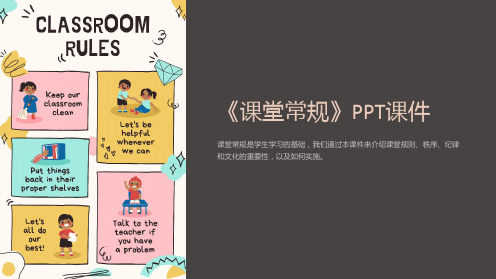课堂行为管理.ppt
《课堂常规》课件

调整心态
学生应调整好心态,保持 积极的学习态度,为课堂 学习做好充分准备。
课堂纪律
尊重教师
学生应尊重教师,遵守课堂纪律,不得在 课堂上大声喧哗、随意走动等。
认真听讲
学生应认真听讲,集中注意力,不得在课 堂上玩手机、睡觉等。
积极参与课堂活动
学生应积极参与课堂活动,与教师和同学 互动,提高课堂学习效果。
认真对待作业
学生应认真对待作业,努力提高作业质量 和学习效果。
及时反馈作业问题
学生应及时反馈作业中存在的问题,以便 教师及时指导和纠正。
03
课堂常规的实施与监督
教师职责
制定明确规定
教师需制定明确的课堂常规,确保学生清 楚了解并遵守。
示范与引导
教师需在课堂常规方面为学生树立良好榜 样,引导学生养成良好习惯。
个性化教学实施方法
采用分层教学、差异化作业、个性化辅导等。
个性化教学的优势
提高学生的学习兴趣和主动性,促进学生的全面发展。
技术手段的运用
信息技术在课堂中的应用
01
利用多媒体课件、网络资源、在线教育平台等技术手段辅助教
学。
技术手段对课堂常规的影响
02
提高教学效率,丰富教学内容,增强师学生需按时完成教师布置的作业和任务。
家长配合
01 了解学校规定
家长需了解学校和班级的课堂 常规要求,以便更好地配合学 校教育。
02 监督孩子行为
家长需在家中监督孩子的行为 ,确保孩子在课堂外也能保持 良好的行为习惯。
03 与教师沟通交流
家长需主动与教师沟通交流, 了解孩子在课堂上的表现和问 题。
课堂常规的重要性
保证教学秩序
课堂常规能够有效地规范 学生的行为,避免课堂混 乱,保证教学活动的正常
开学第一课-行为规范教育 课件(共21张PPT) 小学班会

爱护公物,不在课桌椅、建筑 物和文物古迹上涂抹刻画。损 坏公物要赔偿。拾到东西归还 失主或交公。
认真做值日,保持教室、校园 整洁。保护环境,爱护花草树 木、庄稼和有益动物,不随地 吐痰,不乱扔果皮纸屑等废弃 物。
积极参加集体活动,认真完成集体交 给的任务,少先队员服从队的决议, 不做有损集体荣誉的事,集体成员之 间相互尊重,学会合作。积极参加学 校组织的各种劳动和社会实践活动, 多观察,勤动手
学生常规守则
01
讲诚信。守时履约,言行一致,知错就改,有责任心,不抄袭不
作弊,不擅动他人物品,借东西及时归还。
02
讲法治。遵守校纪校规,参与班级管理,养成规则意识,了解法
律法规,不做违法之事。
03
护安全。红灯停绿灯行,防溺水不玩火,会自护懂求救,远离毒
品,珍惜生命。
04
护健康。养成卫生习惯,不吸烟不喝酒,控制上网时间,抵制不 良信息,坚持锻炼身体,保持阳光心态。
2.爱学习。勤思好问, 乐于探究,上课专心 听讲,勇于发表见解, 按时完成作业,养成 阅读习惯。
3.爱劳动。自己事自 己做,积极承担家务, 主动清洁校园,参与 社会实践,热心志愿 服务,体验劳动创造。
4.讲文明。尊敬父母 师长,平等友善待人, 言行礼貌得体,自觉 礼让排队,保持公共 卫生,爱护公共财物。
2023年小学生
日常行为规范
假期生活已经结束了,我们重返校园,又长大了 一岁,假期生活的舒适悠闲已经离我们而去了,我 们要尽快调整自己的情绪,投入新的学习之中。
第一部分
小学生常规教育
品常行为规范
1.进校门要做到衣冠整洁、端庄,并佩戴红领巾,校卡。 2.对老师和同学讲文明礼貌,不讲粗话,脏话,不起叫绰号,不讲谎话,不骂人、打人、不倚强欺弱、倚大欺小。 3.课内外都遵守学校的纪律和各项规章制度,课间、午间不追逐,不打闹,学校来客不随尾,不围观。 4.进办公室要报告,经老师同意方可进入。 5.爱护公物财物,爱护花草树木,做到不乱涂墙壁、桌、凳等,不坐桌子,不践踏花坛,不攀摘花木。 6.养成良好的卫生习惯,班内自觉做好值日生工作,经常保持教室及学校公共场所的清洁卫生。
教师课堂组织与管理PPT课件

2020/3/24
1
培训目标
使老师们了解课堂掌控的重要性,掌 握课堂掌控技巧
了解各类学生心理,更好的管理和 掌控自己的课堂。
2020/3/24
2
Warming up
抓手指
[目 的]集中注意力。
[方 法] 请教师站成一排,然后把左手张开伸向 左侧人,把右手食指垂直放到右侧人的掌心上 。
• 2、学生与学生集体之间的斗嘴:老师及时提高 音量:Stop! 然后给最先安静下来并且坐好的学 生加分。若学生仍未停止,老师可以直接在竞争 机制上扣除学生的分数同时给老师自己加分
2020/3/24
22
• 幼少儿课堂掌控 之行为艺术
2020/3/24
23
Thank you very much!
2020/3/24
2020/3/24
15
注意事项
• 竞争机制一定要和自己的教学内容紧 密相扣: 1、复习上次课的教学内容 2、输入和操练本次课的重难点内容 3、输入下次课讲要教授的内容
2020/3/24
16
学生交头接耳
• 1、老师可以快速走到学生跟前,严肃的看着学生, 10秒钟后老师继续讲课。
• 2、立即提问,要求学生回答 1) 学生没能回答上来,老师请其他学生帮忙回 答,然后再次要求该学生回答后请他坐下。 2)学生回答出来,老师严肃的看着该学生,要求 学生坐下
2020/3/24
18
发呆
• 1、对其周围的学生进行提问。
• 2、老师边讲课边和学生的眼神对视上并 且严肃的看着学生。
• 3、若老师对周围的学生提问不能够引起 该学生的注意,老师可以对该学生进行 提问。
2020/3/24
课堂管理ppt

课堂管理ppt课堂管理ppt课件课堂管理主要内容第一节课堂管理概述第二节课堂行为管理第三节课堂时空管理第一节课堂管理概述一、课堂管理的概念二、课堂管理的功能三、影响课堂管理的因素一、课堂管理的概念课堂管理:教师通过协调课堂中的各种关系,创建有效的研究环境,促进学生的研究,从而有效实现教学目标的过程。
课堂管理思想的演进:从1950-1970年代注重于控制到如今强调预防问题行为,创建促进学生研究的教学环境,促进学生积极的研究行为和争取成就的行为。
二、课堂管理的功能维持功能促进功能三、影响课堂管理的因素学校背景学生需要与定型期望教师的行为方式与风格班级的特点学校背景学校的环境学校的文化氛围学校领导的管理方式学生需要与定型期望学生的需要教学的目的、内容、方法等是否符合学生的需要将直接影响课堂管理学生对教师行为的期望教师的行为方式与管理风格教师个人经历对课堂管理的影响教师的课堂管理风格权型放任型民主型班级的特点班级的规模班级的氛围班集体的发展阶段第二节课堂纪律管理一、课堂纪律的概述二、课堂纪律的创建与实施三、课堂问题行为管理一、课堂纪律概述(一)课堂纪律:理解专制式观点——通过强迫命令来监督学生行为,纪律建立在惩罚的基础之上放任式观点——学生可以自由调节课堂行为,教师不必过多干涉需要在强制和尊重之间找到一个平衡点,是基于尊重和协商,对学生的课堂行为施加的准则与控制。
他律到自律的连续体。
课堂纪律的类型教师促成的纪律集体促成的纪律任务促成的纪律自我促成的纪律二、课堂纪律的创建与实施(一)课堂规则的建立与学生共同制订规则:清楚地叙述规则:提供规则的原理:解释规则存在的原因;以肯定的方式陈述规则。
良好规则的特征:合理性;清晰明了;可实施可操作性;一致性;灵活性(二)课堂程序的建立程序与规则一样,都是对行为的期望,但程序常只适用于一些具体的活动,通常是用于完成某个行为,而不是禁止某个行为。
需要程序的一般有以下五个领域:(1)学生对教师空间和设施的使用;(2)学生在教室之外的一些活动;(3)学生在集体活动时应遵循的程序;(4)小组讨论时应遵循的程序;(5)附加程序三种纪律实施方式比较三、课堂问题行为管理课堂问题行为界定课堂问题行为的原因课堂问题行为管理策略(一)课堂问题行为界定违反公认的课堂行为规范的行为和明显的心理问题行为。
小学生日常行为规范PPT

保持安静,不发出噪音干扰他人学习
自习室是学习的地方,保持安静的环 境是必要的,以避免干扰他人的学习 。
避免大声说话、嬉戏打闹等行为,共 同营造一个良好的学习氛围。
爱护自习室的设施,保持整洁卫生
自习室的设施是公共财产,每个学生都有责任爱护它们。
人,先下后上,不拥挤。
Part
05
安全规范
注意交通安全,不在马路上玩耍
总结词
遵守交通规则
详细描述
小学生应了解基本的交通规则,过马路时走人行横道,不闯红灯,不在马路上 奔跑、玩耍或停留。
不私自到河边、池塘等危险地方玩耍
总结词
远离危险区域
详细描述
小学生应认识到河边、池塘等地方的危险性,不私自前往玩耍,避免发生溺水等意外事故。
保持自习室的整洁卫生,不乱扔垃圾、不随意涂鸦等,营造一个舒适的学习环境 。
Part
04
礼仪规范
尊敬师长,见到老师要主动问好
见到老师要主动问好,这是对老 师的尊重,也是小学生应有的礼
貌。
在校园内遇到老师,应停下脚步 ,目视老师,标准鞠躬并问好。
无论是在校内还是校外,遇到认 识的老师也要微笑问候或打招呼
认真听讲,积极参与课堂活动
STEP 03
STEP 02
在课堂上要勇于提问,对 于不懂的问题要及时向老 师请教。
STEP 01
积极参与课堂讨论和互动 ,敢于发表自己的观点和 意见。
集中注意力,认真听老师 讲解,并做好笔记。
尊重老师,友善对待同学
对老师要有礼貌,见 到老师要主动问好。
与同学友好相处,互 相帮助,共同进步。
爱护公物,不随意破坏学校设施
课堂管理ppt课件(图文)全

教师通过发展和完善课堂内部结构及其积极的引导作用,能极大地 帮助学生对课堂发生的事件和行为予以恰当的解释;并给予更深刻 的自我反省,形成其责任与自律,实现课堂的自组织
课堂管理的原则
内在性原则:课堂管理过程常常比较 重视教师外在管理的作用,而对学生 的内在管理容易忽略。课堂管理要为 学生的主动性和积极性的发挥规定目 标,提供条件,激发和引导其内在动 机,实现学生的内在控制,这是现代 条件下课堂管理的一个根本性变革。
课堂管理的技巧
及时终止问题行为:
学生的问题行为,大多以轻度为主,因而大部分问题行为只需教师运用一定的影响方法便可得到制止。通常采用的影响 方式包括:信号暗示,使用幽默,创设情境,有意忽视,转移注意,移除媒介,正面批评,劝其暂离课堂,利用惩罚
行为矫正,有效转变问题行为:
课堂问题行为矫正的原则课堂问题行为矫正是一个复杂的过程, 需要做深入细致的工作。在整个过程中应遵循特定的原则。奖 励多于惩罚原则,坚持一般性原则,与心理辅导相结合原则
激励原则
有利教学顺利进行的民主氛围, 激励原则还要求教师在课堂管理 中发扬教学民主,鼓励学生主动 发问、质询和讨论,让学生思维
流程中的浪花不断跳跃激荡
课堂管理的原则
反馈原则:
运用信息反馈原理,对课堂管理进行 主动而自觉的调节和修正,是反馈原 则的基本思想。这既要求教师在教学 工作的起始环节——备课过程中,还 要求教师在课堂教学的过程中,不断 运用即时信息来调整管理活动。
C 可行性。不适当规则会因学生无法遵循而形同虚设,使学生产生“有些规则可以不遵循”的心理。
课堂管理的技巧
课堂规则制定的过程要有学生参与
课堂规则的制定应与学生讨论共同制定,以增加学生对规则的认同感,确保规则得到很好的执行。
有效课堂管理的策略PPT幻灯片

案例:响鼓不用重锤。
5
(三)多理解少疑惑——教育机智。
课堂管理毕竟是一种课堂科学管理行为,教师要
研究它,减少课堂管理方法的随意性,无效性。课堂管
理的最高境界是实现学生的自我管理、自我教育。
当课堂管理已能充分发挥学生主体作用和教师主
导作用时,学生良好的学习习惯和风气基本养成,自控
力、自制力都会大大提高,这时可由学生自我管理。
“管”是为了达到不管,这是我们课堂教学管理的最高
15
另一方面,教师还应当注意课堂客观环境的培植。 如教室的布置要注意颜色的选择和光线的处理。自然适 度的光线有助于师生在教学中的情感交流,促进师生心 理相容。教室空间的合理布局和课桌凳的美观排列不仅 消除了“教学死角”,而且能够使全体学生处于教师视 野之内,从客观上提高课堂管理效果。甚至教师的仪表 对学生同样具有潜在的影响力。如浅色服饰给学生以亲 切感,深色服饰给学生以庄重的“权威”感,艳丽服饰 则易分散学生注意力。教师应讲究朴素大方、整洁,不 穿奇装异服。衣服色调尽以淡雅、调合、鲜明为宜。穿 西装,系上领带,以显气度;穿中山装,系好风纪扣, 以显严谨。这些环境的熏陶,对课堂教学管理的约束力 都是不可或缺的。
(1)引导——管理学习活动朝着预设目标的方向发展。
(2)指导——采取有效方法提升教育活动、学习活动的 质量,提高学习过程的效益,帮助学生对生成的问题进行 价值选择;
(3)导演——策划与设计教育教学活动、教学方法的选 择、教育资源的整合、调度、运用等。
2
二、新课程改革下课堂与学生、教师的变化
遵守课堂纪律主题班会PPT

上课铃声响起后仍未进入教室的 行为被视为迟到。迟到不仅打乱 了课堂的节奏,也是对老师和同
学的不尊重。
早退
在下课铃声响起前离开教室的行为 被视为早退。早退同样会干扰课堂 秩序,影响其他同学的学习。
旷课
未经请假或请假未获批准而缺席课 堂的行为被视为旷课。旷课不仅会 导致学业落后,还会对个人的学习 态度产生负面影响。
05 案例分析:成功与失败的课堂纪律对比
CHAPTER
成功案例分享
案例一
某高中班级,在老师严格要求和学生自 觉遵守下,课堂纪律井然有序。学生们 认真听讲,积极发言,课堂氛围活跃, 教学效果显著。
VS
案例二
某小学班级,老师通过制定详细的课堂规 则和奖惩制度,成功引导学生养成良好的 学习习惯和课堂纪律。学生们自觉遵守规 则,课堂秩序井然,学习效果良好。
培养学生自律品质
增强学生规则意识
遵守课堂纪律要求学生尊重规则、遵守纪律,这有助于培养学生的规则意识和 遵纪守法的好习惯。
提高学生自我管理能力
课堂纪律要求学生自我约束、自我管理,这有助于提高学生的自我管理能力, 为未来的学习和生活奠定基础。
03 常见的课堂违纪行为及后果
CHAPTER
迟到、早退、旷课
CHAPTER
提前预习,认真听讲
提前预习
在课前对即将学习的内容进行预习,了解课程的主要内容和重点,为课堂听讲做 好准备。
认真听讲
在课堂上保持专注,认真听取老师的讲解,积极思考和记录重要知识点。
保持安静,不打扰他人
保持安静
在课堂上保持安静,不发出嘈杂的声 音,避免影响其他同学的学习。
不打扰他人
尊重他人的学习空间,不随意打扰或 干扰其他同学的学习。
2024全新《遵守课堂纪律》ppt课件

整体形象和声誉。
影响学校声誉
03
如果学校中存在普遍的违反课堂纪律现象,将会影响学校的声
誉和形象,进而影响到学校的招生和发展。
受到相应的纪律处分和惩罚
1 2 3
口头警告 对于轻微的违反课堂纪律行为,老师可能会给予 口头警告,提醒学生注意自己的行为。
记过处分 对于较为严重的违纪行为,学校可能会给予记过 处分,记录在学生的个人档案中,对学生的未来 发展产生一定的影响。
不尊重同学
在课堂上对同学进行言语或行为上的攻击、挑衅或歧视,破坏了同 学之间的友谊和团结,影响了班级的整体氛围。
04
遵守课堂纪律的方法和措施
提前预习、认真听讲
提前预习课程内容,了解课程大纲和重点,为课堂听 讲做好准备。
上课时认真听讲,集中注意力,避免分心或做与课堂 无关的事情。
做好笔记,记录重要知识点和例子,以便课后复习和 回顾。
开除学籍 对于严重违反课堂纪律、屡教不改的学生,学校 可能会给予开除学籍的处分,剥夺其在学校继续 学习的资格。
06
加强课堂纪律教育和管理的建议
加强学生自律意识和能力培养
引导学生树立正确的 价值观和纪律观念, 明确课堂纪律的重要 性。
鼓励学生参与课堂互 动,积极发言,提高 课堂参与度。
培养学生的自我约束 能力,自觉遵守课堂 纪律和规定。
了其他同学的学习效果。
打闹
在课堂上进行打闹、嬉戏等行为, 严重破坏了课堂秩序,甚至可能导 致安全事故的发生。
玩手机
在课堂上使用手机进行游戏、聊天 等与课堂无关的活动,不仅分散了 自己的注意力,还可能对其他同学 产生诱惑和干扰。
不尊重老师、同学
不尊重老师
在课堂上对老师进行言语或行为上的攻击、挑衅或侮辱,严重损害 了师生关系和课堂氛围。
《课堂管理》课件.ppt

教师是学生的领导者、朋友、顾 问和管理者。没有任何角色比管
理者更重要。
课堂管理涉及课堂的所有方 面,而且贯穿课堂活动的始终, 如果没有良好的组织和管理技能, 学生和教师两者都将在课堂上陷 入困境。
讨论:
课堂管理包含哪些主 要内容?
教师指令
监测和评估
空间管理
行为管理
资源管理
小组管理
时间管理
课堂规则和程序
• 14、Thank you very much for taking me with you on that splendid outing to London. It was the first time that I had seen the Tower or any of the other famous sights. If I'd gone alone, I couldn't have seen nearly as much, because I wouldn't have known my way about.
学生参与
态度管理
师生间的交流 作品展示
活动2 课堂管理方法与策略
目标:
根据课堂管理要素,分享一 些课堂管理的经验,探讨搞 好课堂管理的方法与策略
中心问题:
我们通过哪些途径 来实施这条管理内容?
•对____的管理,我们 采用的方法 是:______________
___.
新的理念:
新的课堂管理是将管理的工具性 对人性的压抑束缚,变为对学生灵 魂的唤醒,让学生在广阔的五彩的 自由氛围中自我激励,生动成长, 创新发展。因此课堂管理应根据学 生的差异,设置许多不同的管理策 略,使每一个学生都有表达和生长 自己思想的空间与机会,使教师能 关注到学生的内心深处。
《课堂常规》课件

课堂文化
课堂文化的概念
课堂文化是指学生的行为、态度、价值观等在课堂 中的表现。
如何创造良好的课堂文化
教师应注重学生的自主学习、鼓励合作和赞扬积极 表现。
常见的课堂文化问题及解决方法
例如不尊重他人、冲突等问题,教师应指导学生进 行沟通和解决。
课堂文化评估方法
可以通过学生的反馈和课堂氛围来评估课堂文化。
《课堂常规》PPT课件
课堂常规是学生学习的基础,我们通过本课件来介绍课堂规则、秩序、纪律 和文化的重要性,以及如何实施。
课堂规则
为什么需要课堂规则
课堂规则有助于营造良好的学习环境,提高学习 效果。
如何制定课堂规则
与学生共同商讨并遵循教育部的相关指导意见。
常见的课堂规则
如上课时间守时、保持安静等。
如何执行课堂规则
课堂纪律
1 课堂纪律的含义
2 如何促进课堂纪律
课堂纪律是指学生在课堂上遵守的行为规范。
教师应树立榜样,注重教育引导和个体差异 管理,以提高学生的自觉性。
3 常见的课堂纪律问题及解决方法
例如缺席、违反课堂规则等问题,教师应根 据情况进行适当的处罚和引导。
4 课堂纪律评估方法
可以通过学生的出勤记录和纪律违规情况来 评估课堂纪律。
教师应给予正反馈和适当的处罚,以确保规则的 执行。
课堂秩序
1
课堂秩序的重要性
良好的课堂秩序有助于提高学习效果和
如何维护课堂秩序
2
教学质量。
教师应采用积极引导和有效管理等方法
来维护课决方法
例如迟到、打扰他人等问题,可与学生
课堂秩序评估方法
4
讨论检讨和制定解决方案。
可以通过观察学生的行为和学习参与程 度等来评估课堂秩序。
- 1、下载文档前请自行甄别文档内容的完整性,平台不提供额外的编辑、内容补充、找答案等附加服务。
- 2、"仅部分预览"的文档,不可在线预览部分如存在完整性等问题,可反馈申请退款(可完整预览的文档不适用该条件!)。
- 3、如文档侵犯您的权益,请联系客服反馈,我们会尽快为您处理(人工客服工作时间:9:00-18:30)。
辩论题目
• 当学生有违规 • 对学生应以表扬
行为时,应对 鼓励为主,即使
学生进行批评, 学生有违规行为
必要时可实行 也不应斥责处罚
处罚。
他们。
Issues in this chapter are: 本章主要内容
Classroom 课堂中的问题行为
Problem behaviour falls into three categories:
问题行为可分为三类:
1. Off task: not doing what is required by the teacher. 不投入行为:没有进行教师所要求的学习活动的行为
本章列出八种教师可能控制的因素,举出例子 说明这些因素的含义。
3. Read the paper written by Gao Weihong. What are the differences compare Gao’s paper with this Chapter? Do you agree with all her points? If no, why?
按照教师的要求去做称为‘投入’行为。
‘Off task’ behaviour can be defined as that which is incompatible with doing the work requested by a teacher.
没按照教师的要求去做称为‘不投入’行为。
1. Problem Behaviour in the
Problem classroom behaviour is an outcome of a complex set of factors operating at different levels.
课堂中的问题行为是多层次的复杂因素影响的 结果。
• Inadequate housing • Economic conditions • Environmental pollutants • Inadequate curriculum
• About the behavioural approach to classroom management.
课堂管理的“行为习得法”
• About the power of reward
鼓励的作用
‘On task’ behaviour can be defined as that which involves doing the work requested by the teacher.
“行为习得”管理的基本观点是:
a. Most behaviour is learned
多数行为是习得的。 b. Behaviour can be changed through relearning.
通过重新学习可以改变行为。
c. Teachers are in the best position to encourage that relearning. 教师处于一种有利的地位来鼓励重新学习。
Classroom Learning
Chapter 4
Managing classroom Behaviour
课堂行为管理
请关闭手机
Points for Discussion
讨论要点
1. List at least 10 factors which might cause problem classroom behaviours. Give a real story related to a factor in the list.
…
居住条件不佳 经济条件 环境恶化 课程设置不当
…
ቤተ መጻሕፍቲ ባይዱ
2. The Behavioural Approach to Classroom Management
透过“行为习得”方法 进行课堂管理
1) The behavioural approach to managing student behaviour argues that:
d. Teachers should focus on classroom factors under their control. 教师应该注意那些能够有效把握课堂教学因素。
2) Behavioural approach is an approach to managing student behaviour that stresses the role of leaning in the formation of behaviour patterns, emphasizes the need to effect relearning where students exhibit problem behaviour and focuses on the power that ordinary teachers have in encouraging that relearning. Also called ‘behaviour modification’ or ‘positive teaching’
2. Disruptive: stopping others from learning and/or the teacher form teaching. 扰乱行为:扰乱他人学习或老师教学
3. Unruly behaviour: breaking rules or conventions of the class/school. 违规行为:违反课堂/学校的规章制度
• What is meant by ‘on task’ behaviour “投入”行为的意思是什么
• About evidence of misbehaviour in classroom.
课堂上错误行为的例证
• The reasons for this misbehaviour.
产生上述错误行为的原因
列出最少10种可能导致问题行为的原因。针对每种 原因举一个实际的例子。
2. Eight kinds of possible factors under teacher’s control were listed in this chapter, give examples to explain what do these factor mean.
